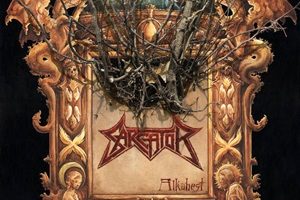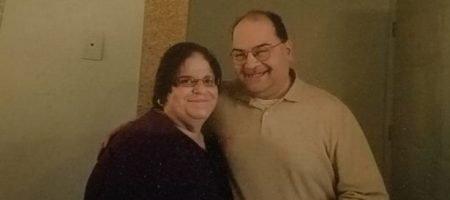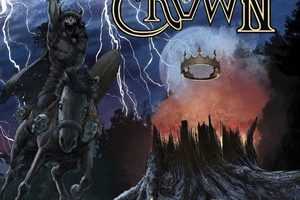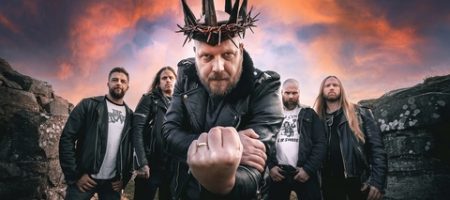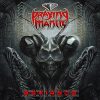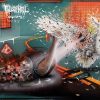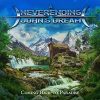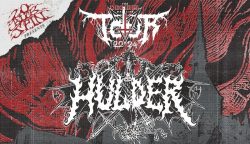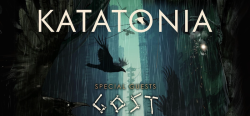The Crown – A Cobra Strike
Wednesday, 7th March 2018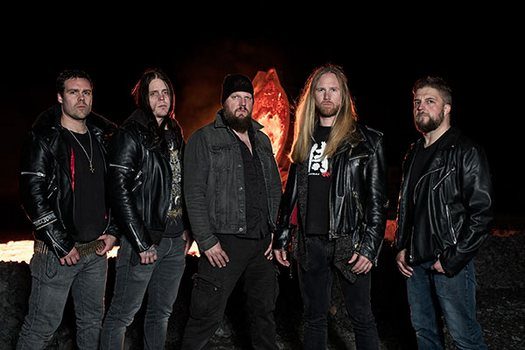
Veterans of the melodic death/thrash extreme metal scene, The Crown started in the early 90’s as Crown of Thorns for two albums on the smaller Swedish label Black Sun, before gaining a deal with Metal Blade who released 1999’s Hell Is Here. They would tour the globe and consistently release new material through 2004’s Crowned Unholy, when the band felt a hiatus was necessary. Five years later they resumed, now gearing up for the release of their tenth studio record in Cobra Speed Venom.
There is no quit in the aggression, energy, and heads down finesse this quintet maintains from front to back. The triumphant riffing against d-beat tempos for “Iron Crown”, the lurking, ominous opening that gives chase to unrelenting brutality for the title cut, or the atmospheric touches and wah-wah lead break action to their metal instrumental “Where My Grave Shall Stand” showcase three different sides to The Crown, and yet all make sense under the umbrella they’ve developed for decades. Reaching out via Skype to guitarist Marko Tervonen for this talk, we tackle his love of audio/production, the versatility of the band through their discography, and how these musicians maintain the balance between band activities along with careers and families.
Dead Rhetoric: Cobra Speed Venom is the latest The Crown record – how did the songwriting and recording process go for this album, were there any specific surprises, challenges, or obstacles that you had to overcome, and how do you feel about the effort now that it’s finally complete?
Marko Tervonen: We tend to create better material when we work things out together in real life in the rehearsal room. We are not the type of band that can be sending files back and forth to each other through computers and the internet. I really believe we create a better end result through this process. This is the way we need to do it- to answer your question, I think the challenges occurred with the previous two The Crown albums, this was pretty smooth when we realized how this band needs to operate.
Dead Rhetoric: Was it a difficult task to figure out what would appear on the main portion of the album versus the three bonus tracks?
Tervonen: Yes, it was. Actually, the original plan was to go into the studio and record 13 songs for the new album. We never intended to do any bonus (material) because I hate that way of thinking, it’s so stupid. Bonus stuff is usually cover songs or your worst songs, and nobody is interested in writing a bad song so that it will be used as a bonus track. It’s a necessary evil. We decided to record all these songs, we notified Metal Blade that we had an album ready, we were about ready to mix it, and it’s 67 minutes long. They said it was too long for a vinyl record- and we said yes, but there are CD’s. They said we needed to remove three songs- actually one of the songs we removed turned up on the B-side for the “Iron Crown” single which was “Ride the Fire”. Basically we needed to remove two songs, and we all argued about it for weeks and we couldn’t agree in the band.
So I called up Andreas at Metal Blade because I know he’s been listening to the band since day one, he is a big fan, and he could decide what two songs to remove and we would not argue about the choices. He decided to put “Nemesis Diamond” and “The Great Dying” as bonus tracks – and I don’t agree with it, but we agreed that we wouldn’t argue with him about it. In some ways we are too close to decide. There are a lot of songs we considered removing, and I thought Metal Blade would put the instrumental “Where My Grave Shall Stand” as a bonus, but they wanted to have it on the album.
Dead Rhetoric: As the artist it’s probably difficult to understand, but do you think about it from the label’s perspective that they believe if an album is too long, it may be detrimental to the enjoyment for the listener?
Tervonen: Exactly. As I said we are a bit too close to decide something like that. I felt a bit relaxed though, because the bonus material today isn’t the same as it was say ten years ago. Ten years ago the bonus was crappy stuff that you wanted to get ahold of from Japan, but today – I realize that all the songs will be available anyway through iTunes, Spotify, etc. That’s where I trusted Andreas to remove two songs- we are interested in the people that enjoy the band that can hear all the songs. In the end if they want to they can find them, so that calmed me down a bit.
Dead Rhetoric: What does latest drummer Henrik Axelsson bring to the table in comparison to long-time member Janne Saarenpää?
Tervonen: It’s like comparing apples to pears- two different guys. Janne is my closest friend, we grew up together- and Henrik is sort of the new guy. I recorded his previous band Implode in my studio years ago – that’s the first time I realized he was a great drummer. He’s younger than we are – he’s a great guy and a great drummer. You can definitely see that we used his skills a lot – there’s a lot of fast stuff on the new album. He’s very skilled. I also love the fact that it was his idea to bring the Roto-drums, those high pitch, old school drums. I really love that – he’s just a cool guy. He lowers the old average of age in the band (laughs).
Dead Rhetoric: Does he help bring a fresh take to the older material as well when he plays out live?
Tervonen: Yes he does. A lot of the times he asks us if he wants us to play things exactly like the way Janne did on the albums. To us, that’s not the purpose- but please play the key elements that are important. He’s not going to change the beats, but he doesn’t need to copy Janne’s every fill. He understands the balance and it works out great.
Dead Rhetoric: You went with artist Christian Sloan Hall this time around for the cover – were you impressed with his work on the last Amon Amarth record to seek him out, and what did you try to go for conceptually?
Tervonen: We also go way back, but I didn’t know it. Christian had contacted (bassist) Magnus Olsfelt around the Deathrace King era of the band and said he was interested in working with us- but I don’t think Magnus even mentioned that to us back then. Now we started to discuss the artwork, he said that Christian Sloan Hall is great – I went on Google, and I was a bit worried because all that I saw that he did was Viking related. I didn’t want any muscular guys on the cover- but then I realized he does a lot of other stuff and he has a really cool style. What finally won me over is the fact that he actually draws up the artwork with a pencil- because we tried the computer stuff on the previous album, and it has its charm – but we are a bit old school and appreciate that style of artwork.
We had this idea with the tidal wave and there are a couple of songs on the album that deal with a sort of theme – not in a political way, but more of a metaphysical way. The idea is the wave represents a state of the world today- that we are getting sucked into a lot of venomous, hateful, dark bullshit that we can’t cover ourselves from. It’s just sweeping across the planet at such a high velocity. With the state of the internet that people share and lie about information, and then their opinions become the truth – you get sucked into a lot of pretty nasty stuff. The tidal wave represents this sucking in of thousands of souls and going full throttle like a tsunami. And the colors of the sunset and dawn- it’s beautiful. I love the fact that the cover has a lot of details – when I fell in love with metal I’m used to staring at cover art and finding the details. Unfortunately the cover work today often ends up as a thumbnail, the people that care though will have great artwork to stare at for hours.
Dead Rhetoric: How do you approach the drums versus the guitar, as you performed double duty on the last The Crown album Death Is Not Dead? Do you believe your skill set at both instruments is beneficial to your overall songwriting outlook?
Tervonen: Yes I do, because ever since our first demo, the thing is when I write a song, I don’t just write the riffs, I write the parts for the drums as well. When I present the song to the guys, I have made a complete demo with the drums. I can’t write a riff if I don’t know how the drums are going to go with it. For Death Is Not Dead, to be the actual drummer doing it, it turns out that I’m not skilled enough. It sounds a bit too tired- going from Janne’s impressive drumming to Death Is Not Dead, the difference is huge. But now, when we have a fast, good drummer, it becomes so obvious how important having a good drummer is for this band. It helps me a lot – I have a lot of drumming ideas. We have a lot of ideas we give to each other – we throw around ideas for the vocals to Johan, and he has ideas as well for some of my melodies. We work together very much.
Dead Rhetoric: Where do your preferences lie, in the studio or on the stage, for The Crown? Or do you gain different levels of excitement through both aspects?
Tervonen: That’s been changing over the years. One interesting thing is that now, I could say almost 50/50. The approach we had for the recording of this album is that we are going to go into the studio and what you are going to hear is our performances. We are not going to let the engineer edit it, we aren’t going to make things sound better than what we are- so what you hear is us playing. We haven’t programmed kick drums, it’s our performances – and that helps a lot when we are about to hit the stage as I know we are up to that level of the album.
That itself is a really interesting topic, as I discussed this recently with a friend of mine. The whole world of what you can do in the studio – if there is a young band, let’s say they are all 20 years old, and this is their first recording in a proper studio. If their first studio experience is a shock, you learn you are not as good as you originally thought. The engineer ends up recording a couple of songs, and he thinks it sounds okay – but asks (the members) if the band wants him to make them sound fantastic. What do you think those guys will say if they are young and not that confident? That’s a lot of the issue today- it’s so overedited, everything ends up sounding so perfect. We are a bit older and more confident, so we said we were going to go into the studio and play the songs. We are not going to be 100% tight, because we are not machines. We are hopefully 98% tight- because this is how we sound, and this is how it will be reflected live. So that approach helps me a lot when we go on stage – I don’t have to feel that we are never going to be able to pull this off.
Dead Rhetoric: As you get older, does it become more of a challenge to develop original material and gain that proper mindset/intensity to execute at a high level given the brand of melodic death/thrash style you’ve developed?
Tervonen: The actual execution of it is not that difficult for me. It’s always a challenge to push yourselves, because I do believe we have our own style. I don’t think we are repeating ourselves. We are sort of working within our own framework, we are childhood friends who fell in love with death metal around the same time. We have sort of borders of what we like and don’t like. It’s easy to see me writing a song that reeks of old Morbid Angel, and no one is going to argue about it within the band. Or Slayer. We really try to push, we don’t want to copy ourselves but the style will be there. The influences and inspiration are not only from death metal – we appreciate stuff from the extreme genres, punk, crust, even rock and roll. Sometimes you sort of realize that just because you can play 260 BPM doesn’t necessarily sound brutal. Sometimes you take things down and play it on a d-beat, or more punkish to sound more aggressive. We mess around with tempos and beats and try to always feel the energy. It would be way too easy to tell Henrik to give me a blast beat and let’s do a four-minute song. For myself, I prefer the dynamics and mess around with tempos.
Dead Rhetoric: When you look back at your musical career, what are some specific stand out moments either on record or stage/tour that you knew you were making an impact or remain special for the memory banks?
Tervonen: Every new experience or new level is always fantastic. I remember getting signed for the first time, having your own debut album, when we signed to Metal Blade and released Hell Is Here. The really big highlights started from there, I just thought it was amazing to be going from a very small, Swedish label to Metal Blade and they got us to tour with Morbid Angel twice in Europe and Cannibal Corpse in the United States for five weeks, with Nile. The tours we did with Morbid Angel and Emperor on the bill, just fantastic. A few years later playing Wacken for over 30,000 people, only a couple of years ago we were in Japan for the first time. That’s the cool thing, there are a lot of goals still to achieve. It’s not like we dwell in the past for the glory days- we have a lot of goals and we are achieving them, so that’s a really good feeling.
Pages: 1 2











